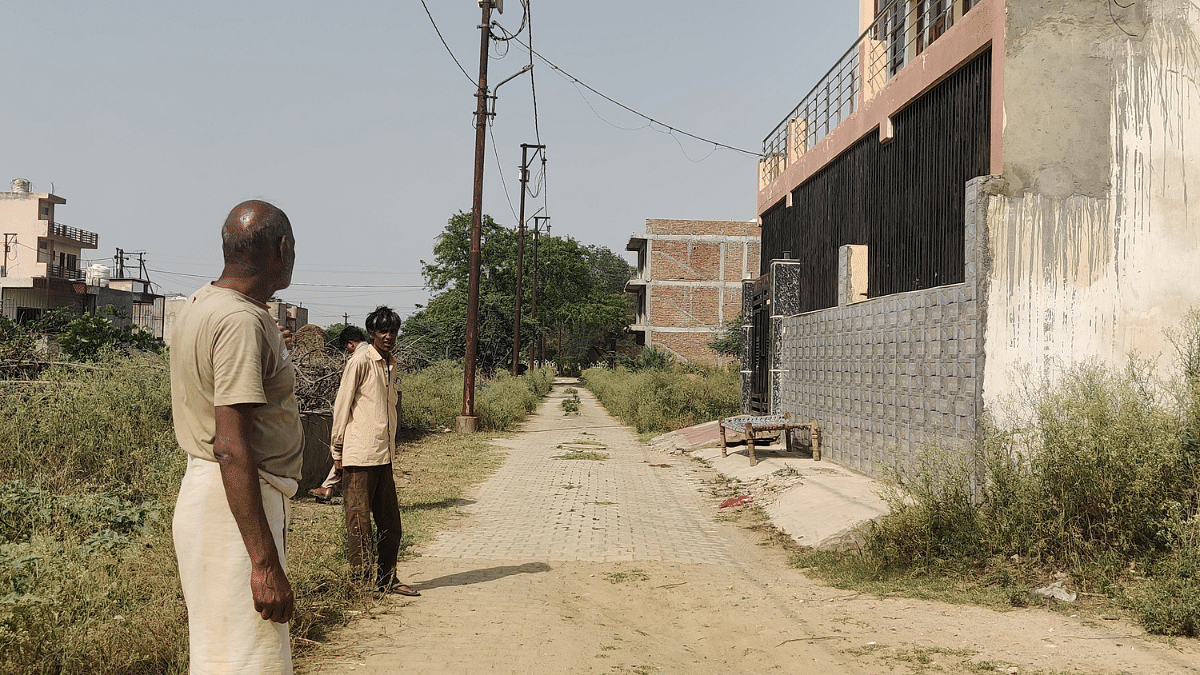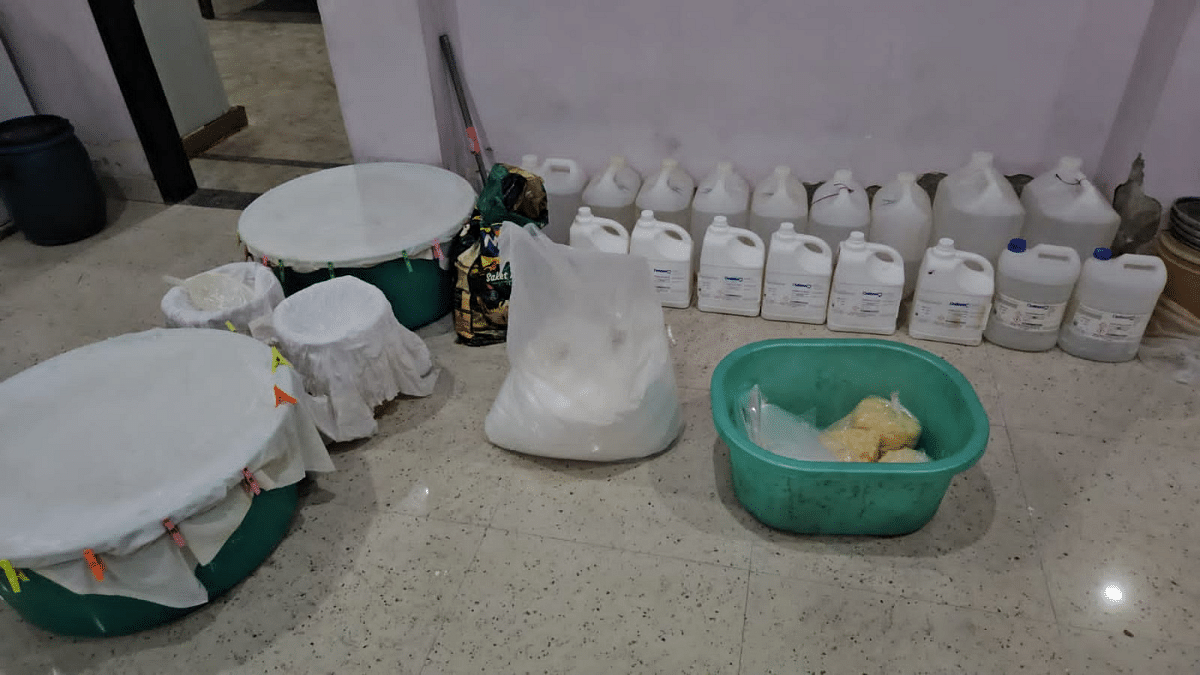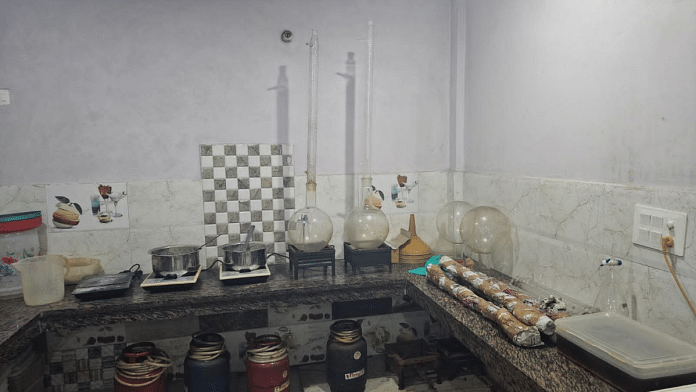Greater Noida/Delhi: Beakers, Florence flasks, pipettes, Bunsen burners, an assortment of acids and chemicals including iodine crystals — no this is not a scene from Breaking Bad, but a real ‘meth lab’ in Greater Noida’s Jaitpur village, where nine foreigners had allegedly been cooking the party drug for almost a year.
No one got a whiff of what was going on until last week, when police teams raided ‘Sharma’s 279’, a three-storied building standing on a desolate plot. The accused had rented out the first and second floors, which at first glance looked like a normal bachelor pad whose residents, neighbours said, mostly kept to themselves.
Meth, or methamphetamine, a psychostimulant, has taken over the Indian rave scene, leaving heroin and cocaine far behind in the race, a source from Narcotics Control Bureau (NCB) told ThePrint.
“In the past 4-5 years, meth has replaced the rich man’s party drug which was earlier heroin. The infiltration has increased since the Taliban took over Afghanistan. The neighbouring country’s drug trade has always been controlled by the Taliban, and now with it ruling the country, the smuggling has considerably increased,” the source added.
Also known as ‘glass’ and ‘ice’, meth is steadily making inroads into the Indian market and its smuggling and consumption has law enforcement agencies on their toes. This is primarily because meth is not just being trafficked into the country, but also being produced in small, clandestine labs, like the one at Jaitpur, the NCB source revealed.
The local police, anti-narcotics agencies, NCB and DRI are working together to curb its production, trafficking and consumption in India and stop its influx.
According to investigators and photographs of the premises accessed by ThePrint, induction cookers and Bunsen burners at the Jaitpur apartment stayed on almost round the clock, but the neighbours didn’t suspect a thing because of an intricate system of drains and chimneys used to let the waste and fumes out. A series of pipes, spread out in a tentacular fashion, would carry the waste out into the barren land. The lab functioned as a well-oiled machine.

Police raided the premises on 17 May and arrested nine people of African origin. Around 46 kg of methamphetamine — in the “white, purest form” — estimated to be worth Rs 200 crore in the international market was seized, Gautam Buddh Nagar Police Commissioner Laxmi Singh had said at the time.
Substances like methyl alcohol, hypophosphoric acid, hydrosulfuric acid, iodine crystals, ammonia, ephedrine, acetone, sulphur, and copper salt were also recovered — leaving the building’s other residents horrified. Organic meth is made using using plant-based narcotic ephedrine.
The accused in this case allegedly operated both out of Vasant Kunj in Delhi as well as the Jaitpur ‘lab’, police sources told ThePrint.
When ThePrint visited the spot Friday, it found bottles, nozzles and other paraphernalia strewn across an adjacent plot where cows grazed on overgrown grass. Neighbours spoke about how they did not have a clue until police teams reached the area, walked out with the meth, and one of the accused jumped from the first floor in a bid to escape.
Studies have shown how methamphetamine produces fumes that can have severe adverse effects on the human respiratory system, as well as have devastating effects on the environment by polluting water sources and soil.
Police are now investigating how the nine accused got hold of the raw materials, including the banned drug ephedrine, their supply chain, crypto trails and others involved in the syndicate, as well as potential terror links.
The owners of the building, who had rented out the first and second floors for Rs 40,000 to the accused, are also suspects in the case, police sources said.
Also Read: ‘Father to father’: Wankhede submits ‘WhatsApp chats with SRK’ in HC to deny extortion allegation
Why meth
So why is meth gaining popularity in India? A lot has to do with its access, production, cost and potency, NCB sources said, adding that meth is cheaper than cocaine and is almost the same price as heroin. Its effect lasts for over 12 hours, and it is a stimulant drug, unlike heroin, which is a depressant.
According to international market standards, 1 kg of high-purity meth would cost around Rs 5 crore. However, when it hits the streets, the substance is adulterated. Meanwhile, 1 kg of high-quality cocaine would cost around Rs 10 crore.
“The potency of meth is comparatively more than that of heroin. Afghan meth over time has had more consumers, and slowly heroin users are shifting to it due to its considerably ‘better kick’. Users of meth are the richer strata of society. The demand for meth has increased over time due to its wakefulness,” an NCB source told ThePrint.
Days before the Jaitpur ‘lab’ was busted, the NCB in a joint operation with the Navy seized a mothership carrying 2,500 kg of high-purity methamphetamine worth Rs 12,000 crore in the Indian Ocean on 14 May.

The haul found on the ‘mothership’ by the Narcotics Control Bureau on May 14 | By special arrangement
The central agency’s team spent 40 days on the lookout for a vessel, but to their surprise, it turned out to be a ship. Sources told ThePrint that the ship was on its way to Sri Lanka from where smaller fishing vessels would be used for further distribution of the contraband.
The contraband is loaded from multiple vessels and has its sources in the Middle East as well as in Afghanistan, NCB sources said.
Under ‘Operation Samudragupta’, established to launch a crackdown on maritime trafficking of drugs on Indian waters originating from Afghanistan, 3,200 kg of methamphetamine, 500 kg of heroin and 529 kg of hashish have been seized since February 2022.
In February last year, 221 kg of meth was seized along with heroin and hashish on the coast of Gujarat. The drugs were allegedly being brought in from Balochistan and Afghanistan.
Afghan heroin (known as ‘shisha’), so far, had been the major concern for local police, Indian and international investigative agencies for years. However, according to sources in the NCB, the last 4-5 years have shown that a major chunk of the drug influx in the country is dominated by meth from Afghanistan, as well as the banned drug ephedrine, through the already existing well-oiled heroin smuggling route.
This, senior officials in NCB said, is somewhat a new trend that has emerged since the Taliban takeover of Afghanistan.
In September last year, the Special Cell of Delhi Police arrested two Afghan nationals and seized 312 kg of methamphetamine along with 10 kg of heroin.
At that time, Special Commissioner of Police (Special Cell) H.S. Dhaliwal had said that meth is “gradually replacing heroin as the preferred financing option for terror operations” highlighting the brewing nexus of “narco-terrorism”.
The FIR in the case was lodged under sections of the Unlawful Activities Prevention Act (UAPA). Containers and other raw materials were seized from the house of one of the accused.
However, according to reports and studies, the trend of Afghanistan’s in-house meth production had already been in place since after 2017-2018, with a tremendous rise in seizures — 935 kg in 2019 up from a few grams in 2008.
In 2020, the Sri Lankan Navy reportedly seized 400 kg of heroin along with 100 kg meth more than a thousand kilometres off the country’s coast, revealing the worrisome trend of Afghanistan’s heroin trade being taken over by this contraband.
In October last year, 234 kg of crystal meth was reportedly seized by the NCB off the coast of Gujarat from a fishing boat, which was also allegedly sourced from Afghanistan.
Also Read: Smack & ‘solution’ are consuming Delhi’s homeless kids. For them it’s a refuge
Growing role of Afghanistan
A European Monitoring Centre for Drugs and Drug Addiction (EMCDDA) report from 2020 noted Afghanistan’s emerging role as a globally significant supplier and producer of methamphetamine.
The report highlights the significant shift from making meth using pseudoephedrine — a comparatively tedious task involving extraction from cough syrups and decongestants — to using plant-based narcotic ephedrine, extracted from the Ephedra plant, locally known as ‘Oman’.

Chemicals like methyl alcohol, hypophosphoric acid, hydrosulfuric acid, iodine crystals, among others seized by the police from the Greater Noida apartment | By special arrangement
The discovery of this plant, a wild crop known to grow in the mountains, led to an alleged boom in the meth industry in Afghanistan.
The 2021-22 Directorate of Revenue Intelligence (DRI) Report also noted the increase in the production and trafficking of methamphetamine from Afghanistan. While in 2019-2020, 142 kg of the contraband were seized under the Narcotic Drugs and Psychotropic Substances (NDPS) Act by the DRI, it rose to 884 kg in 2021-22, the report said.
Ephedrine, a predominant component of meth produced in Afghanistan, is a prized contraband commodity, and its over-the-counter trade as a drug and retail sale is banned in India. Only controlled manufacturing for pharmaceuticals, usage in cold medicines and cough syrups, is legalised in the country.
“Ephedra cultivation is very organised in Afghanistan. In India, pharmaceuticals have to register with the NCB and submit regular reports on the usage of the chemical. This recent bust of the meth lab (in Greater Noida) and other past seizures of ephedrine reveal a troublesome trend. Either it is being trafficked into the country or there have been diversions on legal routes,” said an NCB source.
Last year, the DRI busted another such clandestine factory in Haryana that was allegedly illicitly manufacturing ephedrine and seized over 660 kg of the banned substance.
Hidden in oranges, Chinese tea
According to sources in the NCB and DRI, meth is being brought into the country in two ways — through legal channels, by declaring them as another product, and through smaller fishing vessels in maritime channels.
In the 14 May drug bust in the Indian Ocean, the meth was packaged in plastic bags without any concealment. However, in other cases, it is mostly concealed in containers, toys, among other things.
In a drug bust in Mumbai last year, the DRI reportedly seized 198 kg of high-purity crystal methamphetamine along with 9 kg cocaine. The contraband was concealed in a truck, in packages containing oranges.
In 2020, the Chennai police reportedly seized 9 crore worth of meth (9 kg) in packets marked as ‘tea’ in Chinese letters, drifting near the shores.
“Consignments from different places are loaded from smaller vessels into a mothership. This mothership then drops off the loads into other smaller vessels, mostly fishing boats to be offloaded at various destinations,” a source in the DRI told ThePrint.
Crystal meth from Afghanistan is often routed through the middle east via Dubai into South Asia. According to sources in the NCB, large quantities of meth produced and trafficked into India are then sent through sea routes to Sri Lanka, Australia, New Zealand and other markets.
The main operations of meth in Afghanistan take place in Farah, Herat, and Nimroz provinces which border Iran. The most popular routes into South Asia and other markets are via Iran and Turkey, sources in NCB said.
Moreover, the Golden Triangle — situated in South-East Asia and comprising parts of Myanmar, Thailand, the Lao People’s Democratic Republic and Vietnam — has also been known to be used by drug traffickers both for production and smuggling.
Meanwhile, Yaba tablets — a cocktail of methamphetamine and caffeine — have been a major cause of concern in the Northeastern states due to their porous borders. The influx is majorly from Myanmar into Mizoram, Manipur and other northeastern states, sources in the NCB said.
In March this year, meth-manufacturing drugs worth Rs 390 crore were seized in Mizoram, which highlighted the smuggling of pseudoephedrine from India to Myanmar.
These seizures of clandestine meth and meth-precursor labs hint at the growth of demand and the drug’s illicit trade.
(Edited by Richa Mishra)
Also Read: Heroin and human trafficking are the only two sectors of Afghanistan economy still thriving






